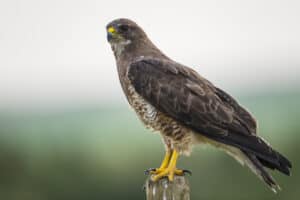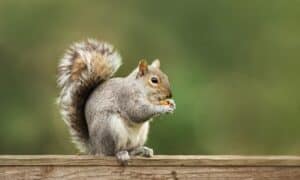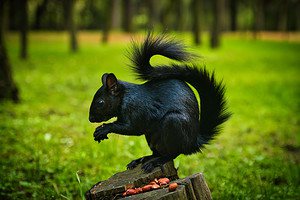You’ve probably looked out the window into your yard with a steamy, creamy cup of coffee in hand only to watch curious squirrel behavior. These erratic creatures sometimes jump from branch to branch and sometimes approach your home to gather nuts. But they can’t eat all of the ones they grab — so into the ground they go. But why? Discover why squirrels hurriedly bury nuts in the ground!
Types of Squirrels
Grey Squirrels
Scientific name: Sciurus carolinensis
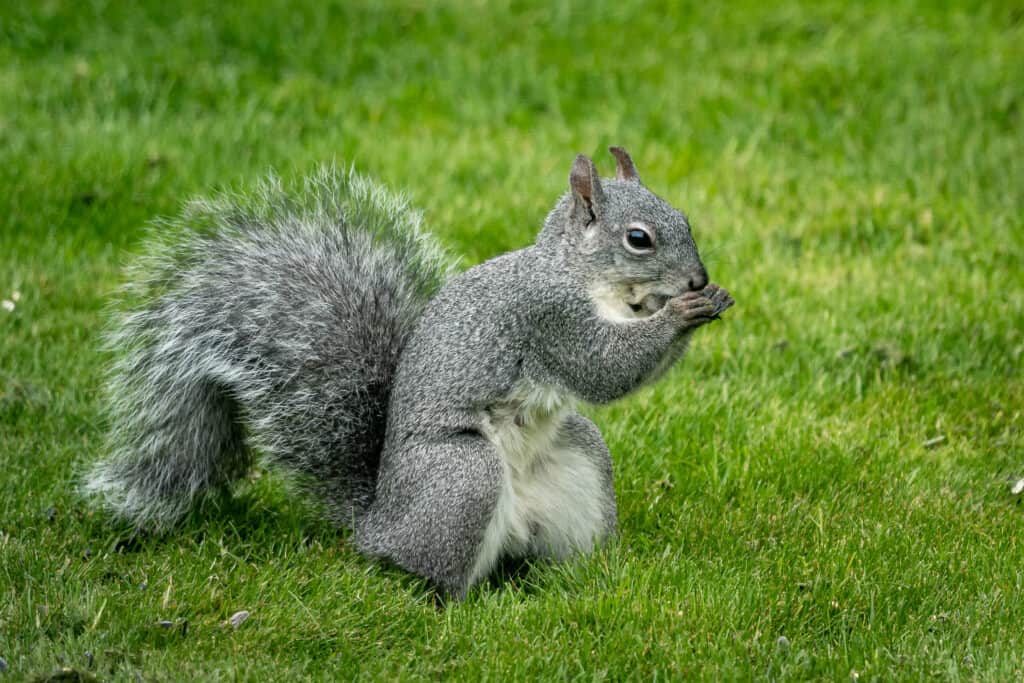
There are over 200
squirrel
species worldwide.
©d murk photographs/Shutterstock.com
In size, grey squirrels are about nine to 11 inches (23 to 28 centimeters) long. Their color is grayish brown on top with a much lighter color on their bellies. Their tails are almost as long as their bodies! These squirrels are native to the eastern and central regions of the U.S., though they now live in different parts of the world. They are easily adaptable, and they can live happily in the forest as well as in parks or gardens in more urban environments.
Fox Squirrels
Scientific name: Sciurus niger
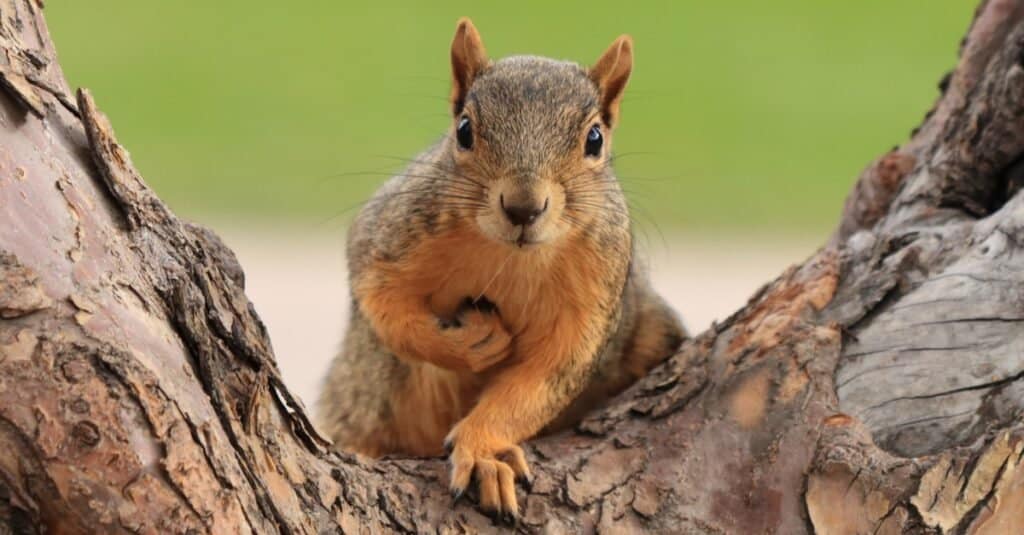
Fox squirrels are most active during the day.
©Vaclav Matous/Shutterstock.com
Adult fox squirrels measure anywhere from 17 to 27 inches (43 to 69 centimeters), including their precious tails which (like with grey squirrels) can be just as long as the length of their body. Their fur color can vary. It often incorporates different shades of brown, black, and even red. Their bellies can have a warm color, appearing reddish. These squirrels live contentedly in wooded neighborhoods as well as in forests. They are most active during the day.
Red Squirrels
Scientific name: Sciurus vulgaris (Eurasian)
Scientific name: Tamiasciurus hudsonicus (American)
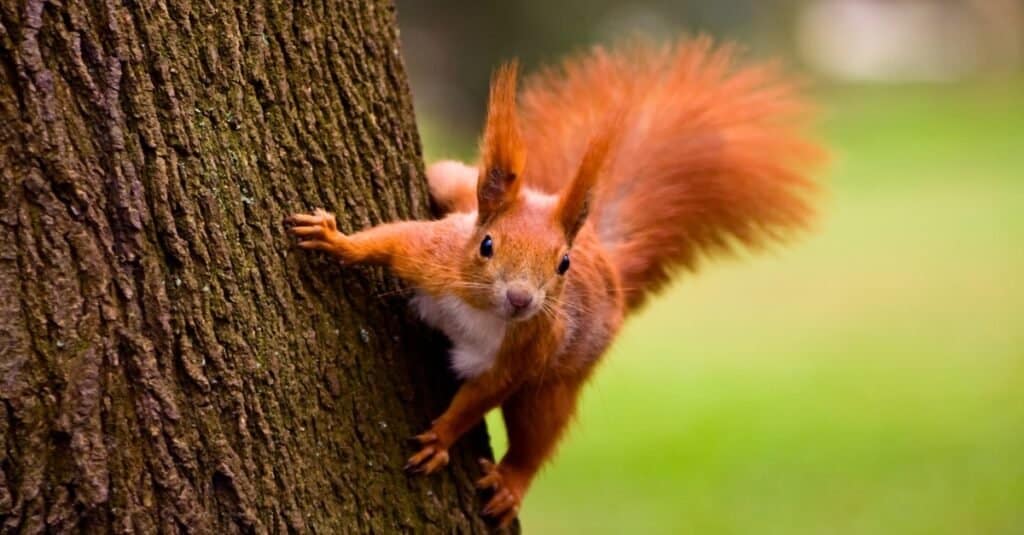
Red squirrels (Sciurus vulgaris) are known for their striking orange-red fur.
©seawhisper/Shutterstock.com
These squirrels measure about seven to 11 inches (18 to 28 centimeters) long and their tails add an additional 4.5 to seven inches to their total length. Eurasian red squirrels are usually smaller than American red squirrels. Despite what their name suggests, red squirrels are not all red. They are gray-red during the winter and change in the summer to more of an orange-red. This is known as seasonal molting. Their white bellies remain the same year-round. Whenever they see intruders that encroach upon their territory, they whistle at them as a warning. Their preferred habitat is in the northern part of the U.S. where it gets cold during the winter season. In Europe and Asia, they inhabit forested areas as well as suburban and urban environments.
Ground Squirrels
Scientific name: O. beecheyi
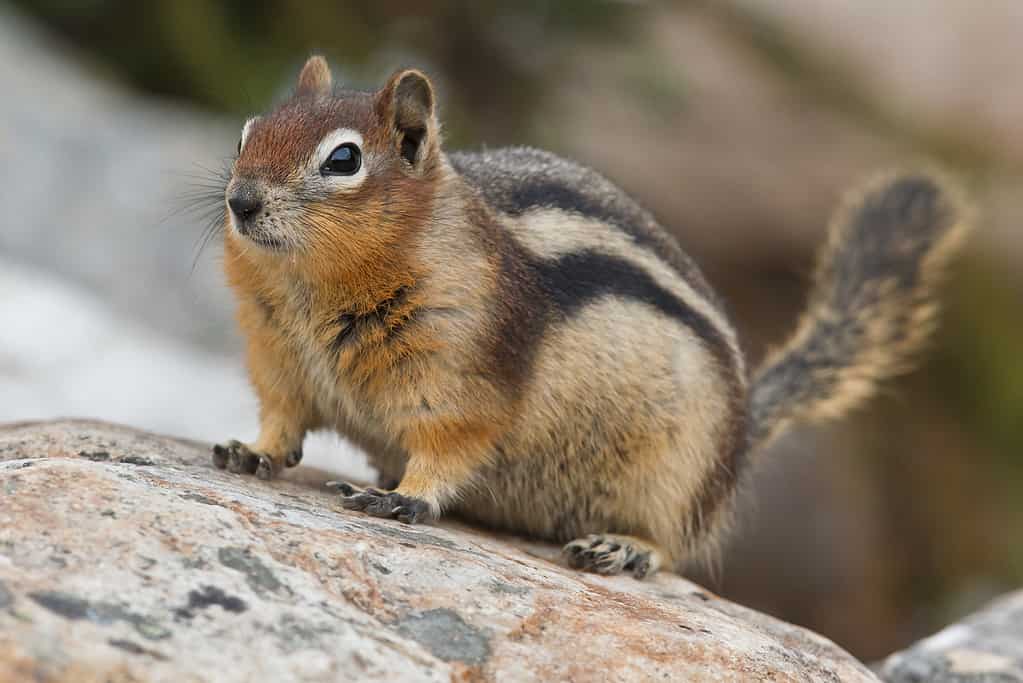
The golden-mantled ground squirrel has stripes on its back and its fur is a range of colors.
©Rafa Irusta/Shutterstock.com
The ground squirrel species can vary from region to region but generally speaking, they are eight to 12 inches long (20 to 30 centimeters) long. Their tails alone add another four to 10 inches (10 to 25 centimeters). Their colorations vary as well, and they can have spots or stripes of reddish-brown fur as well as gray or shades of brown. One of their habitats includes deserts where they dig burrows for shelter. However, they also enjoy living in grasslands and meadows.
Flying Squirrels
Scientific name: Pteromyini
Adult flying squirrels can measure around eight to 12 inches (20 to 30 centimeters) in length. Their fur tends to be dense and soft. The most distinctive characteristic of flying squirrels is a thin, furry membrane called a patagium. The patagium goes from their wrists to their ankles and is what allows them to glide through the air.
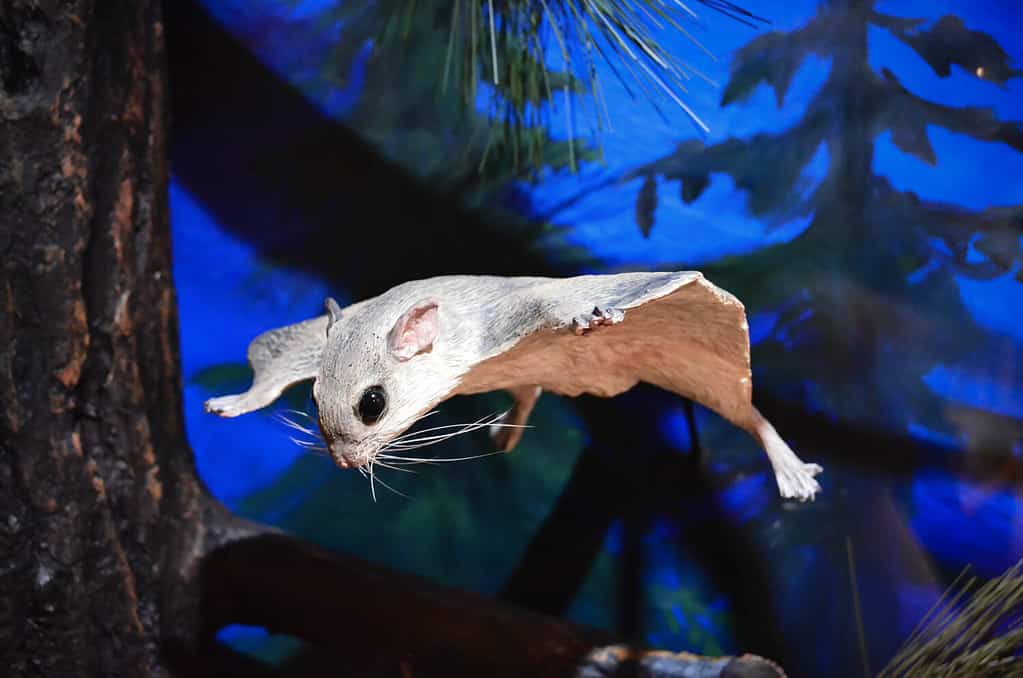
Flying squirrels don’t exactly fly – but they do glide.
©andysartworks/Shutterstock.com
Squirrel Behavior
To communicate with others, squirrels use vocalizations that include chirping. They use sounds as warning calls as well as body postures and tail movements to communicate. Squirrels that live in the city get used to humans handing them food, so they go to feeders and forage for whatever they can find on the ground. In city environments, they adapt nicely to the presence of humans.
Diet
Squirrels are omnivores, meaning they eat a varied diet that includes both animals and plants. They do have a couple of staples in their diet, depending on where they live. They’re most known for their love of several different types of nuts. They also eat seeds, fruits, vegetation, and insects. Squirrels snack on human foods, too. It’s much less common for squirrels to eat rodents, birds, or bird eggs, but it does happen. They are opportunistic, after all.
Nesting
For squirrels to survive and reproduce, they need to engage in nesting behavior. They build their nests in several places depending on their habitats and their species. However, it’s common to see them in tree hollows and branches. If they find cozy spots in manmade buildings (like attics), they may choose to nest there as well. However, ground squirrels stick to the ground and instead of nesting with an aerial view, burrow themselves to create a safe nest.
The nests serve to offer them protection — not only from predators but from adverse weather conditions as well. Nests are their homes and squirrels are not afraid to defend their territories. They keep up with their nests the way you do with your home. If something requires repair, they focus on fixing it up to keep it comfortable and safe, especially for their offspring. When squirrels have kits, their nests serve an even more precious purpose.
Territory
Squirrels are territorial when it comes to their nesting sites, and you might see an otherwise minding-its-own business squirrel get quite defensive. However, this isn’t the only territorial behavior they engage in. They also use their scent glands to mark their territory, letting other squirrels know that “This place is taken!” If an outsider squirrel encroaches, the resident squirrel gets up in arms. This behavior is especially common during the breeding season.
Why Squirrels Bury Nuts in the Ground
Squirrels bury their nuts in the ground for a couple of reasons. This behavior is called “caching,” and describes how these small mammals store food to later retrieve it. The following are some of the reasons why squirrels squirrel away their meals:
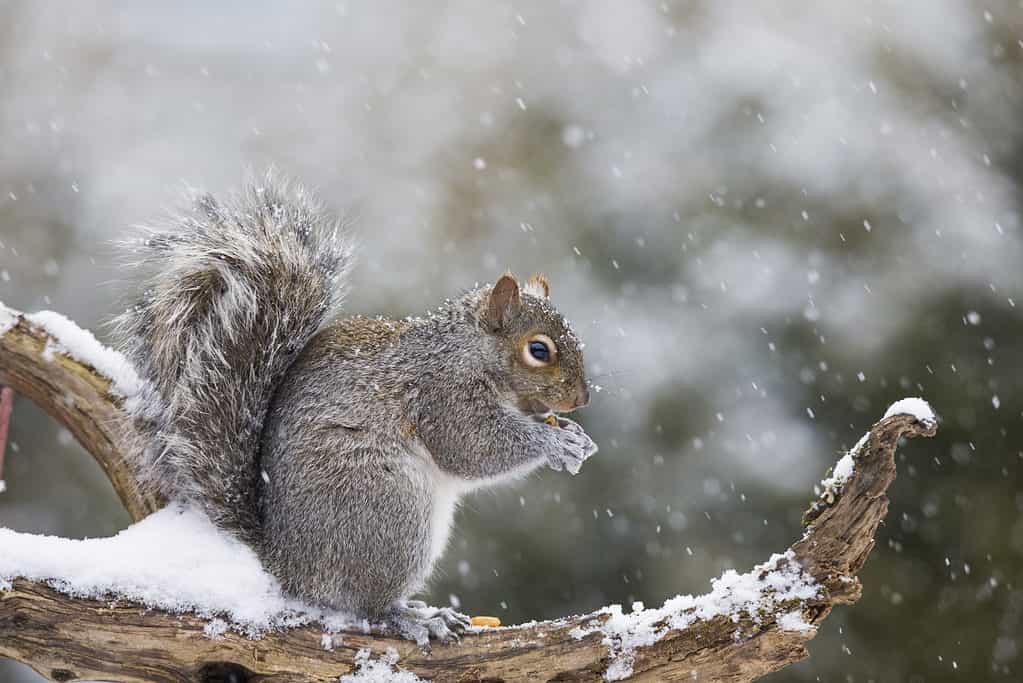
During the winter season, squirrels rely on the nuts they’ve stashed away.
©Mircea Costina/Shutterstock.com
Winter Season Storage
This is one of the most important reasons why squirrels bury their nuts in the ground. When the winter season rolls around, food becomes scarce, especially in colder climates. Squirrels take advantage during the seasons when nuts abound and snatch them up. This shows their opportunistic tendencies as they grab as many as they can and store them for their inevitable future needs.
Competition Avoidance
Another reason squirrels bury their nuts is to simply avoid competition. After they snag several nuts, they head off to different locations and store them. By doing this, they reduce the chance that other squirrels get into their storage spots and clean them out. Even if one storage location is raided, they still have others to rely on.
Proactivity Against Thieves
Other animals like chipmunks can steal a squirrel’s stash. By burying their nuts, they keep their goods safe from thieving hands. Eventually, when they retrieve them during the winter months, they have themselves some energy-efficient, nutrient-dense snacks to get them through the cold weather.
How Do Squirrels Remember Where They Stashed Their Nuts?
Squirrels have impressive spatial memory, which is how they’re able to remember the different locations where they’ve stored their nuts. They remember distinctive features of the area, including certain types of trees or rocks or even nearby manmade structures like sheds or fountains.
Not only do they rely on their spatial memory, but they also rely on scent. They leave their own scent trail that leads to each of their caches, and they practice finding them. Each time they revisit their cached nuts, they reinforce their memory. They also employ different strategies. While they go for depth with some caches, others they keep shallow.
The photo featured at the top of this post is © Koen Adriaenssen/Shutterstock.com
Thank you for reading! Have some feedback for us? Contact the AZ Animals editorial team.



